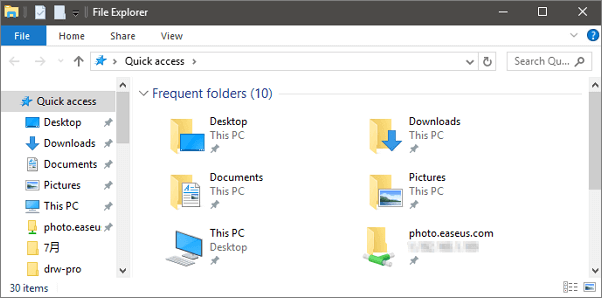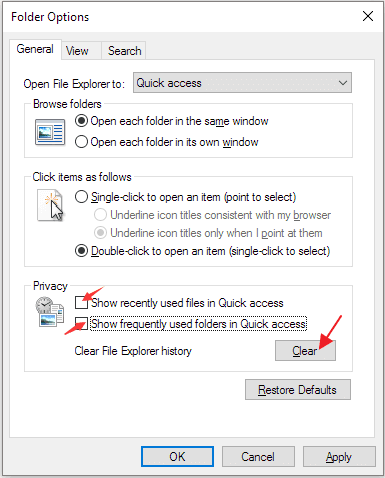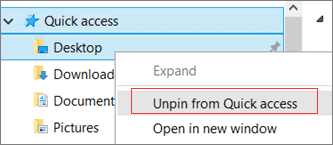Quick Navigation to Quick Access Not Working:
| Workable Solutions | Step-by-step Troubleshooting |
|---|---|
| Bonus Tip - Recover Data First | Select a location to scan > select the files > recover lost data....Full steps |
| Fix 1. Disable Quick Access | Launch File Explorer, click on View > Options > Change folder and search options...Full steps |
| Fix 2. Delete Related APP Data | Launch File Explorer and respectively paste the following folder paths...Full steps |
Overview - What Is a Quick Access
Windows 10 introduced the Quick Access view to File Explorer. That's one of Windows 10's new features. Whenever you open a File Explorer window, you’ll see a list of frequent folders and recent files in the navigation pane. It works like the old "Favorites" list of Windows, letting you pin your favorite folders for easy access. This is very handy. But some people say that their quick access not working.
In a previous post, we worked out a way to troubleshoot Windows 10 Quick Access folders missing problem. And in today's post, we'll continue another "Quick Access" topic - Quick Access is not working, broken, not responding or becomes extremely slow to load/open.

What to Do First When Quick Access Not Working
Each of the mentioned Quick Access malfunctioning issues would prevent you from accessing files and folders. And many people said that they did a system restore for the first attempt, they lost quite a few computer files and lately installed programs. To deal with Quick Access problems without worrying about losing your files, recover data first. Download EaseUS EaseUS Data Recovery Wizard on your Windows 10 PC. Launch it automatically after a successful installation.
Then, follow the details to recover files from quick access:
Two Fixes - Quick Access Not Working/Responding, Crashing All the Time
Once you find Quick Access not working normally as it should, try to disable and then re-enable it. Or else, manually delete some related %appdata% files.
You May Also Like:
1. Disable Quick Access
You should ask File Explorer to open files or folders to This PC instead of Quick Access.
- Step 1: Launch File Explorer, click on View > Options > Change folder and search options. Now you opened Folder Options.
- Step 2: Uncheck the two options "Show recently used files in Quick Access" and "Show frequently used folders in Quick Access" under Privacy. Click "Clear" to clear File Explorer history. Click OK.

2. Clear/Delete Related APP Data Files
Step 1: Launch File Explorer and respectively paste the following folder paths into the Address bar and hit Enter.
- %AppData%\Microsoft\Windows\Recent\AutomaticDestinations
- %AppData%\Microsoft\Windows\Recent\CustomDestinations
Step 2: Select all the files in the opened folder and delete them all.
You can also navigate to this to delete them:
HKEY_CURRENT_USER\Software\Microsoft\Windows\CurrentVersion\Explorer\Ribbon
How to Fix Quick Access Is Slow to Load or Open
You need to clean up Quick Access when it takes a long time to load or open. Besides clear the File Explorer history while disabling Quick Access, do one more step to unpin some large folders like Desktop, Downloads, Windows, etc.
To unpin a selected folder from Quick Access, simply right-click on the folder and choose "Unpin from Quick Access".

Was This Page Helpful?
Updated by Tracy King
Tracy became a member of the EaseUS content team in 2013. Being a technical writer for over 10 years, she is enthusiastic about sharing tips to assist readers in resolving complex issues in disk management, file transfer, PC & Mac performance optimization, etc., like an expert.
Jean is recognized as one of the most professional writers in EaseUS. She has kept improving her writing skills over the past 10 years and helped millions of her readers solve their tech problems on PC, Mac, and iOS devices.
Related Articles
-
Computer Restarts When Playing Games | 10 Fixes🔥
![author icon]() Jerry/2024-10-25
Jerry/2024-10-25 -
How to Fix Black Screen of Death Windows 10 in 8 Different Ways
![author icon]() Jerry/2024-10-25
Jerry/2024-10-25 -
How to Solve OneDrive Sync Pending Error in Every Possible Way
![author icon]() Jerry/2024-07-01
Jerry/2024-07-01 -
Task Manager Not Opening or Responding in Windows
![author icon]() Brithny/2024-11-25
Brithny/2024-11-25
EaseUS Data Recovery Services
EaseUS data recovery experts have uneaqualed expertise to repair disks/systems and salvage data from all devices like RAID, HDD, SSD, USB, etc.
